----------------------------------------------------
LICHENS
- AN EXPERIMENTAL PAGE
Special
page devoted to lichen news and observations - help
appreciated
Lichen
identification web sites
British Lichens . . .
http://www.lichens.lastdragon.org/Caloplaca_citrina.html
Irish Lichens . . .
http://www.irishlichens.ie/index.html
National History
Museum Guide to Lichens on Twigs . . .
http://www.nhm.ac.uk/nature-online/life/plants-fungi/lichen-id-guide/index.dsml
HOLLYBANK
WOODS - 19 March 2013
Lichen
- Usnea subfloridana
Ralph Hollins pointed
out that my photo taken on Mar 13 could have been one
of two Usnea species depending on the colour of the
main stem. This was not clear in the original photo.
U. subfloridana is black at the base of the
stem where it joins the tree whereas U.cornuta
stem is grey/green throughout. I looked very
closely at several specimens of this fruticose lichen
on the Birch and I am fairly certain that the base of
the stem is back which suggests the species is Usnea
subfloridana. The black base does not show well on the
photos taken in the field, but it does show clearly
when viewed in a microscope. Here is a photo I took
through my microscope at magnification x20 showing the
black base.
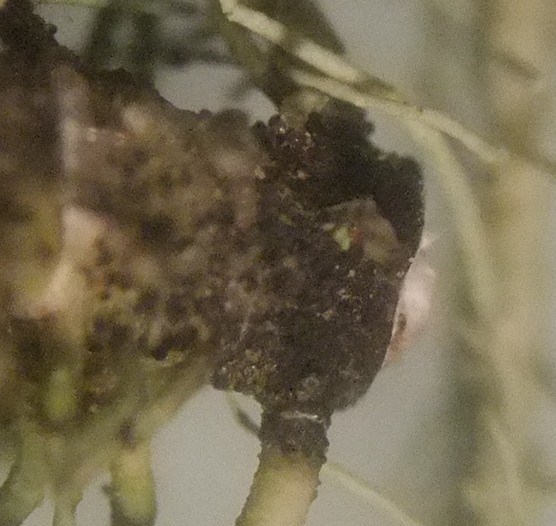
Lichen
on Ash sapling - Xanthoria parietina
?
I stopped by Peter
Pond to admire the abundant growth of a yellow foliose
lichen on a Ash sapling on the south bank by the main
road. This lichen has numerous jam tart-shaped
fruiting bodies and broad lobes which resemble the
white of a fried egg. My tentative identification is
Xanthoria parietina This lichen is very
common throughout Britain, on nutrient-enriched bark
and stonework, often abundant on coastal rocks,
increasing as a result of nitrate/ammonia deposition
from atmospheric pollution. http://www.lichens.lastdragon.org/Xanthoria_parietina.html

Lichen
on Oak tree - Amandinea punctata ?
There is a good growth
of a crustose lichen on the trunk of a young Oak tree
on the east side of the north meadow. Its thallus
consists of a number of thin crusts arranged roughly
horizontally on the bark of the tree varying in colour
from pale to darker grey. The darker crusts have a
number of spaced, almost black, rounded fruiting
bodies (apothecia) and the lighter crusts have pale
cup-shaped fruiting bodies. Assuming I am looking at
one species of lichen on the tree, these presumably
are different stages in the development of the lichen.
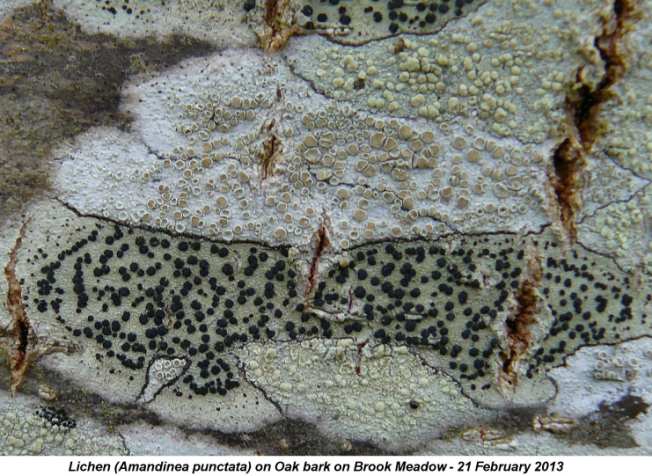
From the National
History Museum Guide to Lichens on Twigs I have
tentatively identified this lichen as Amandinea
punctata See . . . http://www.nhm.ac.uk/nature-online/life/plants-fungi/lichen-id-guide/index.dsml
This lichen is
described as . . . "A widespread lichen on
nutrient-rich bark and wood, also found on nutrient
enriched rocks and debris. Tolerant of pollution and
inorganic fertilisers. Very variable. Thallus pale to
dark grey, inconspicuous, thin or thick, prothallus
rarely present. Numerous flat to slightly convex,
small black apothecia with thin margins. Pycnidia are
sparse."
Possible alternative -
Arthopyrenia antecellans
Lichen
on Elder on Brook Meadow
There is a dense
growth of yellow foliose lichen on the bark of the
dead Elder tree on the main river path opposite the
Bulrushes.
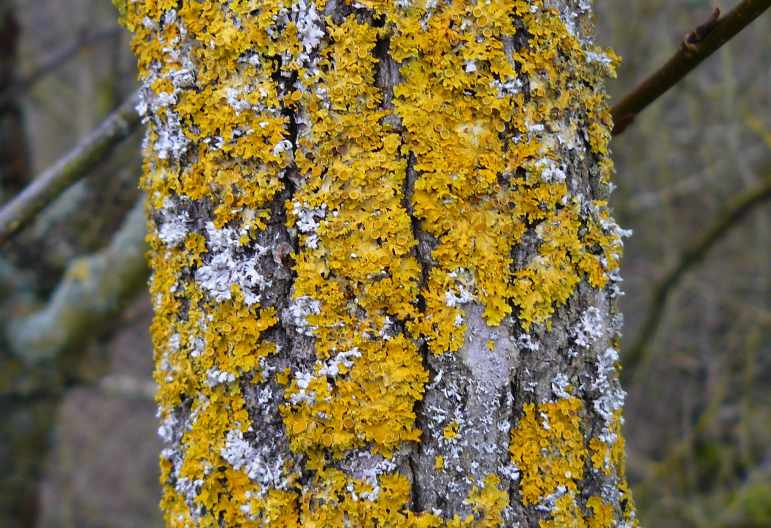
My tentative
identification is Xanthoria parientina
which shows the distinctive cup-like fruiting bodies
under the microscope.
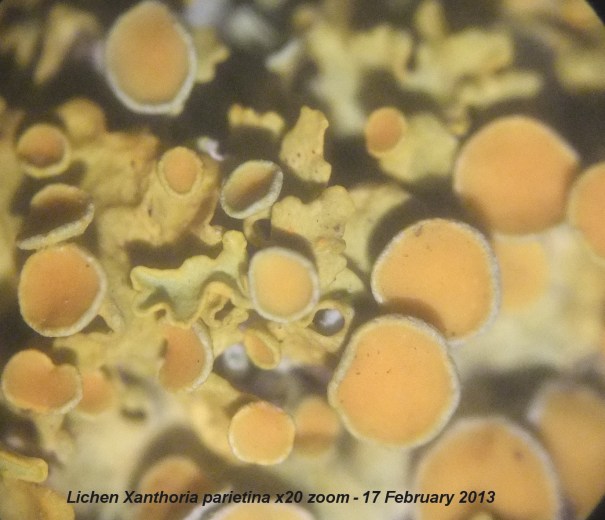
Shore
rock lichen - Caloplaca citrina?
Yellow crustose lichen
is abundant on the large rocks along the shoreline of
Western Parade. Is this another example of
Caloplaca citrina? It occurs on coastal rocks.
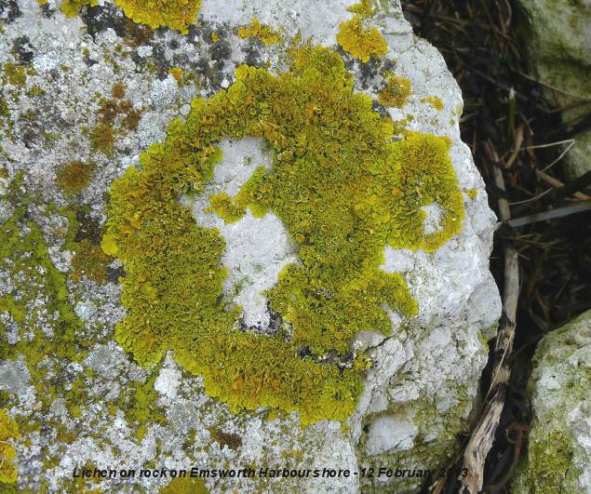
Metal
gate lichen - Caloplaca citrina?
I found two more
interesting lichens today. A yellow crustose type
lichen is growing on the metal gate in the front
garden of our house in Bridge Road, Emsworth. This
could be another example of Caloplaca citrina, which
Alan Silverdale's web site says does occur on metal
fences. http://www.lichens.lastdragon.org/Caloplaca_citrina.html
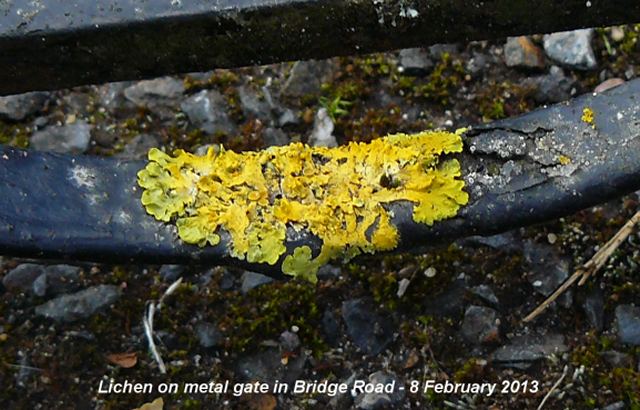
Brick
wall lichen - ??
Another lichen that
caught my eye was on a brick wall on the north side of
Victoria Road. It was similar to the other white
crustose lichens. But it was composed mostly of tiny
white spots and not the usual large patches as in
chewing gum lichen. I have been through the crustose
lichens on the Irish web site without seeing anything
close. http://www.irishlichens.ie/lich-cru-r.html

Millpond
seawall lichen - Caloplaca flavescens? or -
Caloplaca citrina?
During my walk around
the millpond, I noticed lots of yellow crustose
lichens growing on the edges. Maybe, it is the same
species that I saw on the gravestones in Warblington
Churchyard? Caloplaca flavescens? See photos on
web site . . . http://www.lichens.lastdragon.org/Caloplaca_flavescens.html

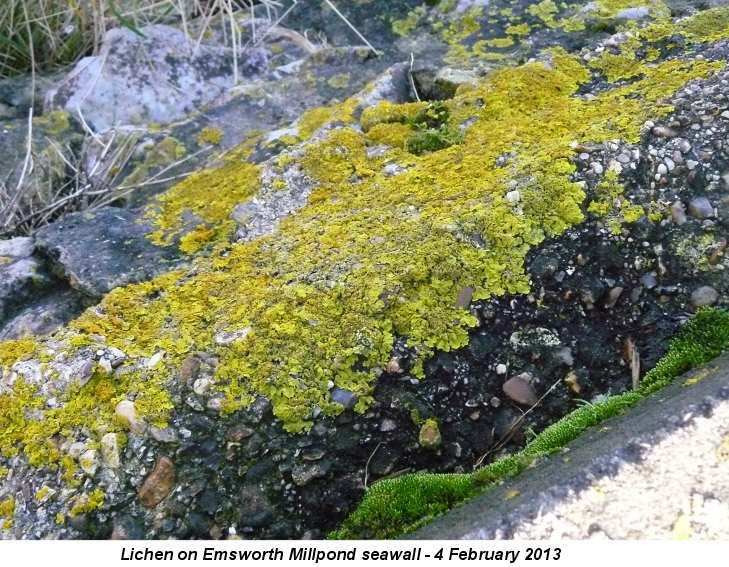
Warblington
Church gravestones - Caloplaca citrina?
Lots of lichen were
growing on the old headstones in the churchyard, all
of the crustose type and varying in colour from white,
through yellow to black.
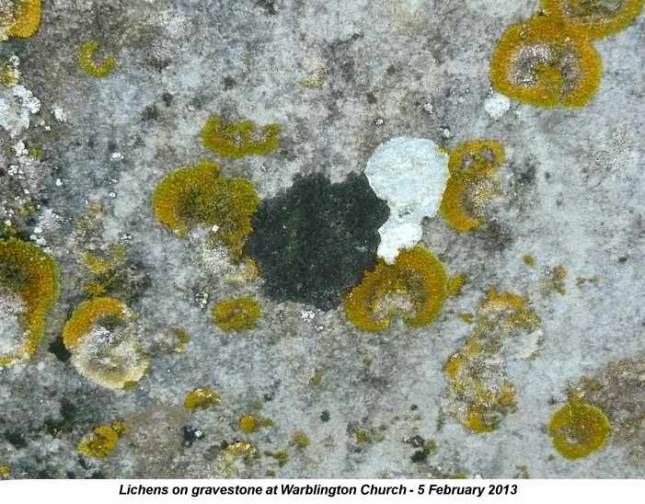
Chewing
gum lichen - Lecanora
muralis
This is common on
pavements and resembles discarded chewing gum. The
tough upper surface of the lichen is made up of
thousands of tightly packed filaments which collect
the nutrients and moisture in the air. People walking
over it helps the lichen to spread. This lichen was
first seen in London in 1960 and now it is found on
pavements all over Britain. We have quite a lot on the
paving on our patio at the back of the house, where
they seem to prefer the concrete slabs to the red
bricks.
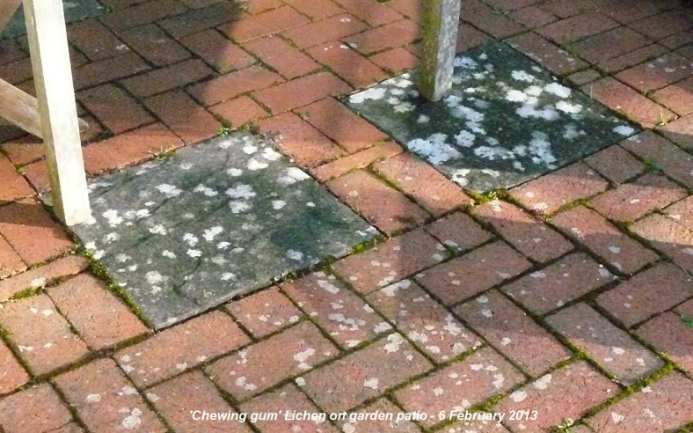
Blackthorn
twig lichen - Xanthoria parietina?
I went on a lichen
hunt and found examples of the three main forms. 1.
crustose - lichens that form patches of
negligible thickness that cannot be scaraped off; 2.
foliose - lichens composed of more visible
"flakes"; and 3. fruticose - little
hairy/fibrous "bushy" lichens that mostly frequent
trees. Classifying the lichens is about as far as I
can go at present!
At the far eastern end
of the north path on Brook Meadow I found a yellow and
grey lichen of the foliose type growing on the twigs
of the Blackthorn bushes. Possibly the same species in
different stages of development? Xanthoria
parietina?

Oak
tree lichen
I found more of the
grey 'bushy' lichen of the fruticose type on an Oak
tree on the path west of Nore Barn Woods.
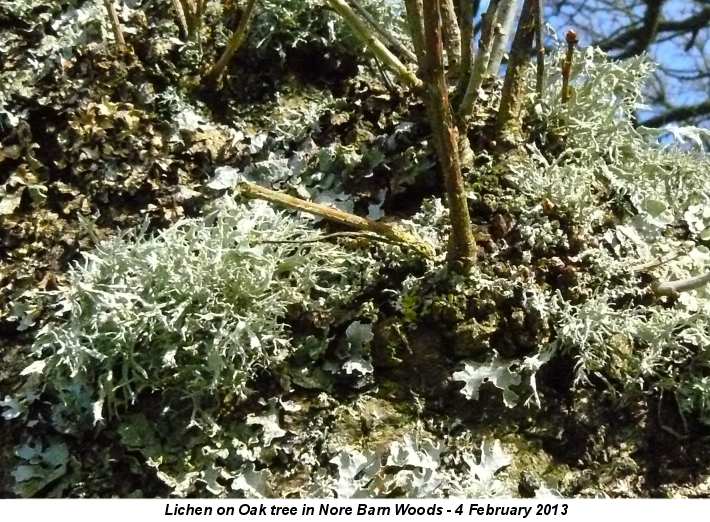
Brick
wall lichen - Caloplaca citrina?
There is a rather fine
growth of yellow lichen on the brick wall of one of
the gardens in Lumley Road. I don't know what species
this is, but I see it around quite a lot.
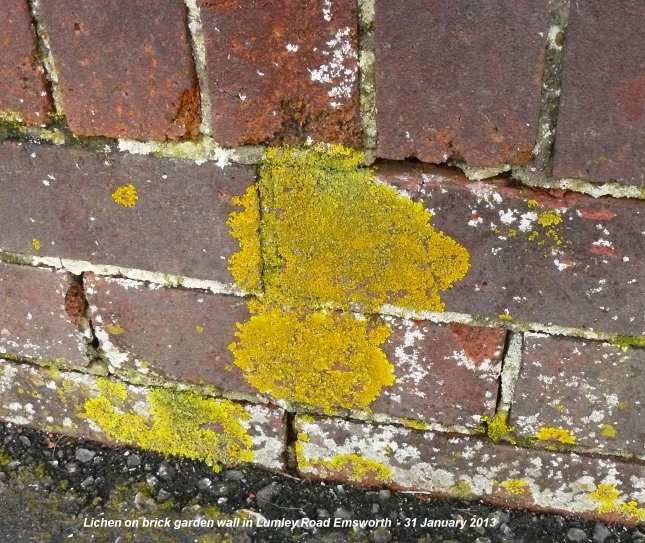
Lichen
on Blackthorn twig - Xanthoria parietina
?
I broke off a small
twig from a Blackthorn bush on Peter Pond which had a
healthy growth of lime green lichen on it. The lichen
has flat broad lobes and many cup-shaped
spore-producing bodies which show up clearly under the
microscope. It reminded me of a moonscape. My
calculated guess is that it is Xanthoria
parietina which is said to be very common on
rocks, walls, trees, etc. A lichen is usually
described as a thallus, not as a plant. It is a
composite organism consisting of a fungus and an alga
living in a symbiotic relationship.
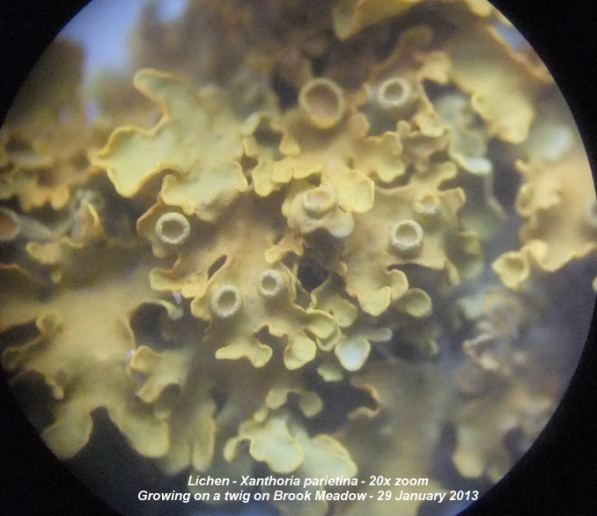
'Pollution
lichen' - Lecanora
conizaeoides
Last night (8.30pm on
Monday 21st Jan), I watched the first of what looks
like an interesting new 6 part series on Channel 4
called 'Wild Things' produced by Plantlife people. If
you can put up with the adverts and the rather crass
presentation the programme is well worth watching
again. The show is presented by Chris Myers, a
landscape designer from Yorkshire, Plantlife's Dr
Trevor Dines as expert botanist, and Sally Eaton
(Edinburgh Botanic Garden and formerly Plantlife) as
expert lichenologist.
Most interesting was
the story of the lichen Lecanora
conizaeoides which started off by being one of
the rarist species in Britain, then became one of the
most common and now has become one of the rarist
again. This lichen has a layer of crystals that keep
the water out and thus make it resistant to air
pollution. Thus, it thrived during the bad old days
when acid rain was a problem. However, with the clean
up of our air, other lichens which were damaged by
acid rain are now taking over and Lecanora
conizaeoides is in decline. It is sometimes called
'Pollution lichen'.

I have always assumed
from my early reading of John Wyndham's novel 'Trouble
with lichen' that all lichens were vulnerable to air
pollution, but apparently not.
I hightly recommend
looking at the recording of the programme which can be
stopped at critical points . . . http://www.channel4.com/programmes/wild-things/4od
A book, 'The Wild Things Guide to the Changing Plants
of the British Isles' complete with maps,
illustrations and more background information, has
been written to accompany the series.